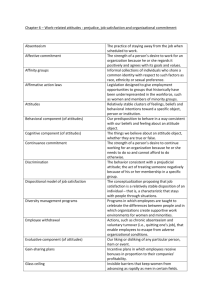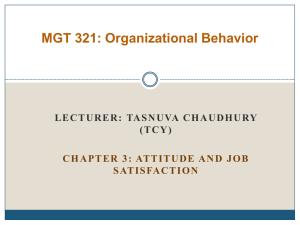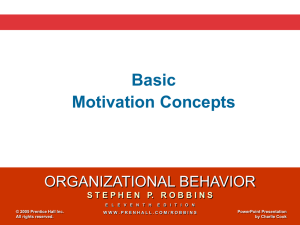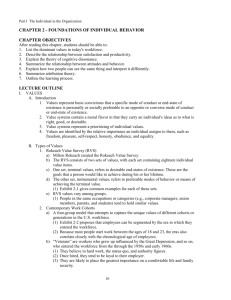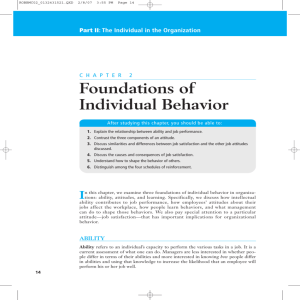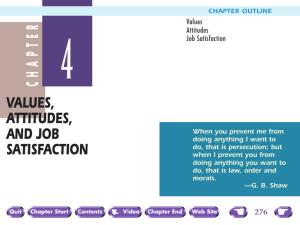ORGANIZATIONAL BEHAVIOR SUMMARY Chapter 3 Attitudes and
advertisement
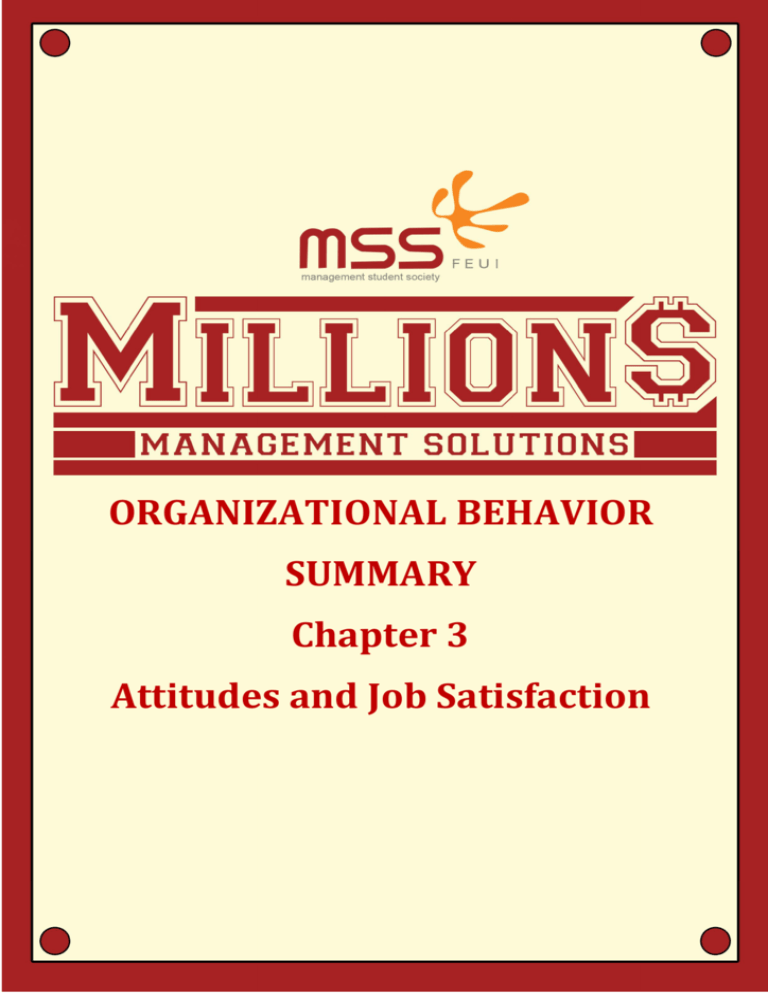
ORGANIZATIONAL BEHAVIOR SUMMARY Chapter 3 Attitudes and Job Satisfaction ATTITUDES Attitudes are evaluative statements – either favorable – about objects, people, or events. Main components of attitudes: - Cognitive = evaluation; a description of or belief in the way things are. Affective = feeling; emotional segment of an attitude. Behavioral = action; intention to behave in a certain way toward something or someone. All components of attitudes are closely related and leads to certain attitudes toward the supervisor. Cognitive dissonance is any incompatibility between two or more attitudes or between behavior and attitudes. Individuals will attempt to reduce inconsistency which is uncomfortable (from Festinger). Desire to reduce dissonance depends on moderating factors, such as: - Importance of the elements creating it. The more important it is, the more motivated people to reduce the dissonance. The degree of influence we believe we have over them. People will be more motivated to reduce dissonance that they can control. Rewards of dissonance. Higher rewards brings people be more motivated to reduce dissonance. Moderating variables is the moderators of the attitudes relationship. They are: - - Importance of attitude; reflect people’s fundamental values, self-interest, or identification with individuals or group they value. Its correspondence to behavior; general attitudes tend to best predict general behavior. Its accessibility; attitudes that our memory can easily access are more likely to predict our behavior. The presence of social pressures; discrepancies between attitudes and behavior tend to occur when social pressures to behave in certain ways hold exceptional power. Whether the person has direct experience with the attitudes. What are major job attitudes? Job attitudes tap positive or negative evaluation that employees hold about aspects of their work environment. - Job satisfaction; describe a positive feeling about a job, result from an evaluation of its characteristics. Higher job satisfaction means employees have positive feeling from his job. - - - Job involvement; measure the degree to which people identify psychologically with their job and consider their perceived performance level important to selfworth. This concept is closely related to psychological empowerment, employee’s beliefs in the degree to which they influence their work environment, their competence, the meaningfulness of their job, and their perceived autonomy. Organizational commitment; identification of employee with a particular organization and its goals and wishes to remain a member. Three separate dimensions: o Affective commitment; emotional attachment to the organization and a belief in its values. o Continuance commitment; the perceived economic value of remaining with an organization. o Normative commitment; an obligation to remain with the organization for moral or ethical reasons. Perceived organizational support (POS); the degree to which employees believe the organization values their contribution and cares about their well-being. Employee engagement; an individual involvement with, satisfaction with, and enthusiasm for, the work she does. High employee engagement will leads to higher level of consumer satisfaction, higher productivity, higher profit, and lower turnover level. JOB SATISFACTION Measuring job satisfaction Two popular approaches: - - Single global rating Use one general question such as “All things considered, how satisfied are you with your job?” Summation of job facets It identifies key elements in a job such as the nature of the work, supervision, present pay, promotion opportunities, and relations with co-workers. What causes job satisfaction? - Job conditions; pay, happiness, passion. Core self-evaluations; bottom-line conclusions individuals have about their capabilities, competence, and worth as person. Responses to job dissatisfaction Active VOICE Active and constructive attempt to improve condition such as suggestions and discussion. EXIT Leaving the organization. Destructive Constructive NEGLECT Passively allows conditions to worsen. Includes chronic absenteeism or lateness, etc LOYALTY Passively but optimistically waiting for conditions to improve. Includes speak up and believing in org. Passive Specific outcomes of job satisfaction and dissatisfaction in the workplace 1. Job satisfaction and job performance Organizations with more satisfied employees tend to be more effective than organization with fewer. 2. Job satisfaction and OCB People who are more satisfied with their jobs are more likely to engage in OCB (organizational citizenship behavior). 3. Job satisfaction and customer satisfaction Satisfied employees increase customer satisfaction and loyalty. 4. Job satisfaction and absenteeism Dissatisfied employee tend to miss work and have high absence rate. 5. Job satisfaction and turnover Job dissatisfaction is more likely to translate into turnover when employment opportunities are plentiful because employees perceive it is easy to move. 6. Job satisfaction and workplace deviance If employees don’t like their work environment, they’ll respond somehow. 7. Managers often “don’t get it”

